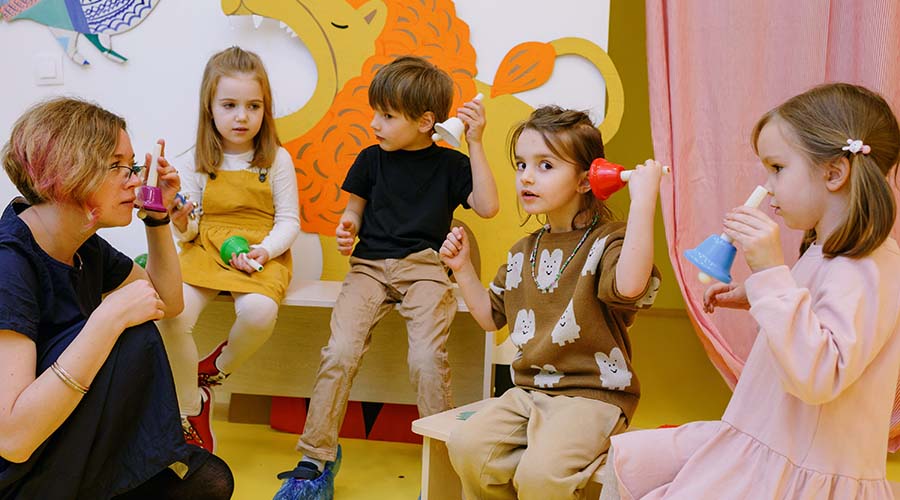settings
children
With Famly since
Early education faces an acute staffing challenge. And while recruitment is difficult, retention is even more so. There’s urgency in holding on to good staff members, and we need them to function well.
I’ve heard from a lot of early education leaders describing difficulties with new hires. They say their new starters seem hesitant to engage with children, or unsure about their roles at a new child care center.
At the same time, stressed child care directors aren’t always proactive in their approach to onboarding and nurturing their new teaching staff, who are critical to the smooth running of their day to day operations.
Often, the new hire is ushered into their child care classroom with a quick intro: “Hey Kris, here’s your new assistant Maddie. She will be great. You two have a good day!” Kris is dealing with a toddler dispute over a pink stuffed pig. She tells Maddie to do diaper checks, and the ‘good day’ is underway. It’s likely to end not so well. The cortisol level rises for the toddlers, Maddie gets frustrated with her uncertain role, and Kris runs out of patience with her new assistant.
If this situation seems familiar, it’s time for a better alternative. So in this article, I want to offer you some simple ideas to make the entry of new workers into your daily operations less rushed and more welcoming.

Who are the new workers in child care?
New hires in early childhood education tend to be young people who sign on with good intentions, and a love of children.
Often, they’ll answer a common job description:
Assistant Child Care Workers are responsible for the well-being of the children under their care. They monitor the children to ensure that they play and interact with one another in a safe and appropriate manner.
Never mind that below this paragraph, there is a long list of tasks in ECE jargon. To this new hire, the job duties seem simple enough: play with children and make sure they’re safe.
Many of these new workers in early childhood education are part of Gen Z. Taken as a demographic, the Pew Research Center describes Gen Z’ers as wanting to make a difference, socially-minded, and caring toward others. They are focused on their work and are tech-savvy.
Due to their youth, they are likely to have limited technical experience in early childhood education, and with lots to learn in their knowledge of child development. While there will be individual differences, child care directors and managers should keep this profile in mind, as they look to attract and retain new educators.
The main objective is to keep new staff members engaged, so they feel valued and productive in our child care programs. We need them.
Let’s look at how we can keep our new hires’ characteristics in mind, as we shape our programs and daily operations to support them.
What makes new workers feel able to make a difference in child care?
Welcome them with care. Ask them what they want to contribute to your program, what their strengths are, and about some areas where they would like some help.
Get to know your teaching staff with a simple ‘welcome form,’ and remember to share about yourself too. Here is a brief example from my own book, Evaluating and Supporting Early Childhood Teachers.
Welcome to our center. We are very happy to have you on our staff. Please answer these few questions to help us get to know better:
- My strengths are:
- I want to know more about:
- I prefer communication by (Check top two): Email, text, written notes, bulletin board, or in person
- Two things very important to me in the workplace are:
- When I am not at work, I enjoy:

Setting up for success: emphasizing new workers’ caring traits
Early childhood education is a “people’s business.” It’s about being sensitive and caring, and requires good interpersonal skills with both children and other adults.
But this can also be draining without positive feedback.
Your new worker needs reassurance and motivation to do the job. So even though you're busy with many responsibilities as a center director, you should take the time to observe them on the job each day.
If you like what you see, make a positive comment when you get a chance: “I noticed you were reading to Pao, Lia, and Matt together this morning. They were so interested in the story when you made the animal sounds. Great teaching moment!”
Or send them an affirming text message: “Thanks for comforting Lia when her mom left today. She recovered quickly!”
If you do have a concern, arrange a private meeting at nap time or at the end of the day, to offer resources for the situation. It may be a short video, or an article on a developmentally appropriate way to read to toddlers. That all depends on where you think they could build their strengths. Reassure your new team member that you want to support their teaching skills and professional development, so they advance in their career in early childhood education.
What if your new teacher has limited experience in child care?
Have a short, up to date staff handbook that matches the job description directly, clearly listing the tasks required.
Let’s take an example. If the job description says: “Ensure healthy practices,” the direct task is “to do diaper checks every hour, and change diapers as needed.”
Making things concrete removes room for misunderstandings, and takes the guesswork out of a new hire’s first days.
They might not read the thirty-eight-page document that you have for your permanent lead teachers. But they can read the two page list of expectations with optional and non-negotiable tasks.
Explain the tasks and expectations in terms of child development principles, and the quality of education you deliver to children and families. In other words, give a ‘why’ behind your policies.
For example, you might not allow cell phones in the classrooms, because adults checking their phones distracts them from the primary function of supervising the physical safety of children — not because you want to deny workers their rights. Then, be specific about when staff can use their phones during scheduled breaks away from children.

3 tips to help new hires get engaged in their work
Any new staff wants to know the details of the work they are expected to do, not figure it out on their own. Your job as a child care director is to plan ahead, to answer common “first-day” questions before they pop up.
Here’s what that might look like:
- Prepare the lead teacher to receive the new assistant. Review the lesson plan with the lead teacher for the first week, and discuss with the teacher where the assistant would be most helpful in your learning environment.
- Provide fifteen minutes for colleagues to meet before they start to work together. That way, everyone can plan their responsibilities before springing into action. Give a list of specific tasks: set food, help children eat, clean tables, change diapers, play in the classroom, play in the playground, and read.
- Encourage contributions. Your new hire may have a favorite book, activity, or song that they can add to the lesson plan. This can be a rewarding and encouraging experience, especially when just starting out.
The big ideas
Your new teachers are tech savvy — make the most of it
Not every new hire comes into your program with early childhood education experience. However, most of them are digital natives, with excellent communication skills on social media. You can use this to everybody's benefit.
Given their tech-native background, the interface of child care management software will be second nature for young people just starting out in early education. If you give them ownership of this, it’s a natural way to draw out their strengths, while entrusting them with utility and responsibility right from the start.
In addition to the direct work with children, you might consider giving your new worker the official responsibility to assist with communication with families, like sending pictures of children and documenting via the “News Feed” of your software application.
To retain new workers, child care directors need to plan proactively
If we’re going to address the retention issue in early education, we’ve got to think of these positions from the perspective of the new employee, just as we think about children’s experiences when they enter our child care center.
We want them to find their place, so they feel respected and valued. We can view the opportunity to welcome this individual to the profession of early childhood education as a privilege.
On the immediate practical side, it’s about having enough adults to meet ratio and introducing them to the basics of health and safety. But more importantly, it’s about giving them the professional foundation of caring for and teaching young children.
In the short term, our sensitivity to their needs and aspirations will make them stick with the job, and retention will stabilize. In the long term, mentoring and growing the skills of young early childhood educators is a priceless contribution to the future of our field.
Free downloadable Early Childhood resources
Explore our library of longer-form books, guides and editable templates - all free to download.
Explore free resources






%20(2).png)

.jpg)
